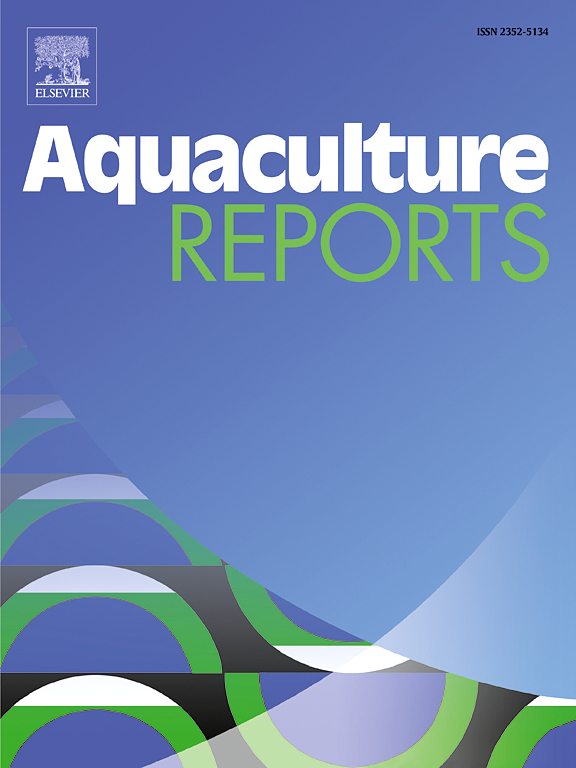Methylation profile of the testes of the flatfish Solea senegalensis
IF 3.7
2区 农林科学
Q1 FISHERIES
引用次数: 0
Abstract
In aquaculture production, fish phenotypes are influenced by a combination of external and internal factors, while the underlying mechanisms often involve distinct DNA methylation patterns. These play a fundamental role in regulating gene expression in response to environmental shifts. The Senegalese sole (Solea senegalensis) holds significant potential in aquaculture due to its high commercial importance. However, its production faces several challenges, including the inability of F1 soles to reproduce. In our study, we analysed the methylation patterns in the testicular DNA of 12 male S. senegalensis individuals from four distinct groups, which differed in rearing origins (wild and F1 soles) and sexual maturity stages (mature and immature). We employed reduced representation bisulfite sequencing to identify significant methylation differences among studied groups. The differential methylation analysis showed a substantial disparity between the F1 and wild groups. This difference was evident in both the number of different methylated CpGs (DMCpGs) and methylation levels, highlighting a distinction in groups reared under different conditions. The comparison between immature and mature wild groups revealed notable differences, suggesting that the testes methylation profile undergoes few changes in wild individuals during sexual maturity. These differences in methylation between wild and hatchery-born and reared offspring imply epigenetic modifications triggered by rearing in captivity and by the absence of natural stimuli such as temperature fluctuations. We further annotated the DMCpGs based on their position and co-localization with genes in the Senegalese sole genome. Our analysis revealed that the methylation differences observed in DMCpGs were more pronounced in intron regions, with higher methylation levels. Conversely, the methylation differences in exon and promoter areas were more subtle. Upon annotation, we discovered that these DMCpG sites were located near or within various transcription factors. Our comprehensive analysis sheds light on the intricate methylation profile of S. senegalensis, focusing on genes associated with reproductive traits, particularly those related to sex determination (SD) systems and spermatogenesis. Overall, we observe a trend toward higher methylation levels in DMCpGs when comparing F1 individuals to wild groups, as well as immature to mature wild groups. Hence, sexual maturity and place of origin resulted in marked methylation differences, which could potentially affect the expressions of genes involved in both development and reproduction of farmed males. This analysis explores the gene-regulating effects of this epigenetic mechanism providing valuable insights into the variations in methylation found in the testes of Senegalese sole.
塞内加尔鳎鱼睾丸的甲基化特征
在水产养殖生产中,鱼类的表型受到外部和内部因素的共同影响,而其潜在机制往往涉及不同的 DNA 甲基化模式。它们在调节基因表达以应对环境变化方面发挥着根本性作用。塞内加尔鳎目鱼(Solea senegalensis)具有很高的商业价值,在水产养殖业中具有很大的潜力。然而,其生产面临着一些挑战,包括 F1 鳎鱼无法繁殖。在我们的研究中,我们分析了来自四个不同群体的 12 条雄性塞内加尔鳎睾丸 DNA 的甲基化模式,这些群体的饲养来源(野生和 F1 鳎)和性成熟阶段(成熟和未成熟)各不相同。我们采用了还原表征亚硫酸氢盐测序技术,以确定研究组间的显著甲基化差异。差异甲基化分析表明,F1组和野生组之间存在巨大差异。这种差异在不同甲基化 CpGs 的数量(DMCpGs)和甲基化水平上都很明显,突显了在不同条件下饲养的群体之间的区别。未成熟组和成熟野生组之间的比较显示出明显的差异,这表明野生个体的睾丸甲基化特征在性成熟过程中几乎没有发生变化。野生后代与孵化后代和人工饲养后代在甲基化方面的这些差异意味着,人工饲养和缺乏温度波动等自然刺激会引发表观遗传学改变。我们根据 DMCpGs 在塞内加尔鳎基因组中的位置及其与基因的共定位对其进行了进一步注释。我们的分析表明,在内含子区域观察到的 DMCpGs 甲基化差异更为明显,甲基化水平更高。相反,外显子和启动子区域的甲基化差异则更为细微。经过注释,我们发现这些 DMCpG 位点位于各种转录因子附近或内部。我们的综合分析揭示了塞内加尔猿复杂的甲基化特征,重点是与生殖特征相关的基因,尤其是与性别决定(SD)系统和精子发生相关的基因。总体而言,我们观察到,在比较 F1个体与野生群体以及未成熟群体与成熟野生群体时,DMCpGs的甲基化水平呈上升趋势。因此,性成熟和原产地导致了明显的甲基化差异,这可能会影响参与养殖雄性个体发育和繁殖的基因的表达。这项分析探讨了这种表观遗传机制对基因的调节作用,为了解塞内加尔鳎目鱼睾丸甲基化的变化提供了宝贵的信息。
本文章由计算机程序翻译,如有差异,请以英文原文为准。
求助全文
约1分钟内获得全文
求助全文
来源期刊

Aquaculture Reports
Agricultural and Biological Sciences-Animal Science and Zoology
CiteScore
5.90
自引率
8.10%
发文量
469
审稿时长
77 days
期刊介绍:
Aquaculture Reports will publish original research papers and reviews documenting outstanding science with a regional context and focus, answering the need for high quality information on novel species, systems and regions in emerging areas of aquaculture research and development, such as integrated multi-trophic aquaculture, urban aquaculture, ornamental, unfed aquaculture, offshore aquaculture and others. Papers having industry research as priority and encompassing product development research or current industry practice are encouraged.
 求助内容:
求助内容: 应助结果提醒方式:
应助结果提醒方式:


